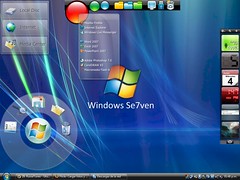Once you're allowed in, Google's new cloud storage service, usually called GDrive, is nice for people who need to find a place to store files so that they can access them on another device or share them with others. You get 5GB of storage for free, and you can buy more. Google Drive is closely linked with Google Docs to the point that they appear to be a single entity.
If you already use Google Docs, then your work will magically appear in GDrive. In fact, when I loaded the Google Drive application on a Windows 7 machine, I found things that I'd stashed in Google Docs for a long forgotten news story and never looked at again. There's nothing like old press releases to bring back memories.
Microsoft, meanwhile, has been working on SkyDrive, which exited the beta program and went into general availability early in 2008. Like Google Drive, it's a cloud-based service and it has applications for your computer. While SkyDrive has been around for years, Microsoft has just released a much improved version of this cloud service, and it offers some things that Google does not. Like GDrive, SkyDrive is also free, but you get 7GB if you're a new user or if you had 25GB when you first signed up, you can keep that.
As was the case with Google Drive and Google Docs, SkyDrive apparently shares some resources with Office 365. When I loaded the new SkyDrive client onto a Windows 7 machine, I found the test documents I'd originally created when testing Office 365. Those were even more boring than the old press releases I'd found in Google Drive.
Google Drive and SkyDrive both support mobile devices, but SkyDrive does a far better job of it. As you'd expect, SkyDrive is available for Windows Phone devices. There you can set your client to automatically upload photos taken with your Windows Phone to your SkyDrive. But SkyDrive is also available for iOS devices and there are a number of apps available from Google Play that support SkyDrive for Android devices. A few Android devices come with a SkyDrive app installed, but most don't. You can even get a SkyDrive app for your BlackBerry.
GDrive, meanwhile, includes an app for Android. Everything else must use a browser to connect to Google Drive, although there are reports that Google will be releasing iOS apps for GDrive at some point. Other mobile devices will have to continue to use their respective browsers, but it's worth noting that not all browsers will work. According to Google's information for GDrive, some older versions of Android won't work with the Drive, even using the browser.
In any case, most recent devices can access either cloud service through their browsers, so if you've not otherwise supported, you've got that.
To start using Google Drive on a computer, you follow a link to drive.google.com and click on the download button. You'll need your Google sign-on to install and use Google Drive. Once the software is installed, you'll have a folder on your desktop with the Google Drive logo.
Getting Skydrive is a similar process: you go to skydrive.live.com and follow the instructions to download SkyDrive for your device. You'll need a Windows Live ID to accomplish this. With SkyDrive your folder will appear in your personal Windows folder, although you can create a shortcut on your desktop. Clients for both services are reached through the app store for your mobile device.
Both services allow sharing of documents, photos, videos and the like. The biggest difference is that people you share with on Google will need to have access to Google Drive. With SkyDrive you can create a link that people can follow even if they don't use SkyDrive. If you use Microsoft Office OneNote, you'll find your notes in your SkyDrive.
Google Drive has been the subject of much hype on the blogosphere lately, with predictions that it spells doom for Dropbox, SkyDrive, iCloud and maybe Box. In reality, GDrive is nice, but it's not substantially nicer than anything else. While Google Drive is now linked directly to Google Docs, that only matters if you use Google Docs. If you don't-and most people don't-then Google Drive is yet another nice cloud storage option.
It's worth noting that there's been much discussion about Google's terms of service that seem to say that even though you retain ownership of the material you store on Google's services, they have the right to use the material, including the right to display it in public. If you plan to use Google's Drive for your business, you should probably have your legal staff take a look at this. But that caution is true of any cloud service you use.
If I had to pick one of these services at this point in time, it would be the new version of SkyDrive. I can find a SkyDrive client for every device in my office and they all work. That's something I can't do with Google Drive. But that may change and if it does, then what matters is if the cloud service supports the devices you need.
To follow Wayne Rash on Twitter, click here [link omitted]
To Follow Wayne Rash on Google Plus, Click here [link omitted].
Source Citation
Rash, Wayne. "Google Ships a GDrive Thats No Better than Microsofts New SkyDrive 503152." eWeek 28 Apr. 2012. Computer Database. Web. 1 May 2012.
Document URL
http://go.galegroup.com/ps/i.do?id=GALE%7CA287994838&v=2.1&u=22054_acld&it=r&p=CDB&sw=w
Gale Document Number: GALE|A287994838


No comments:
Post a Comment